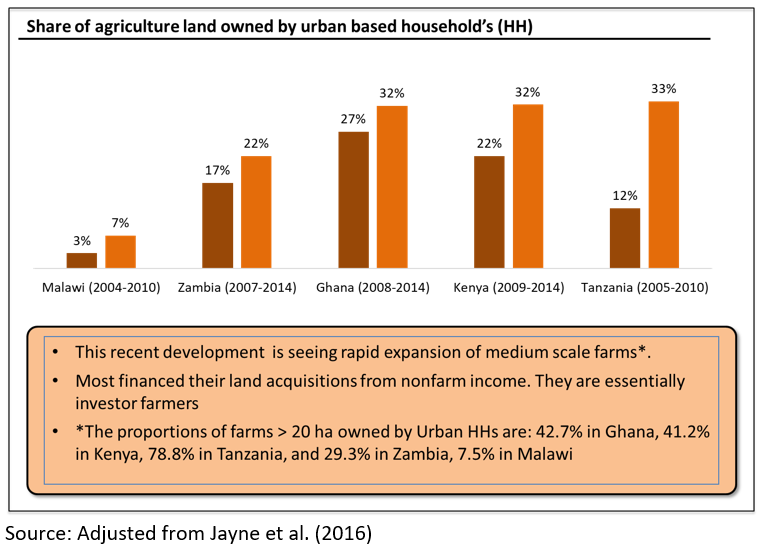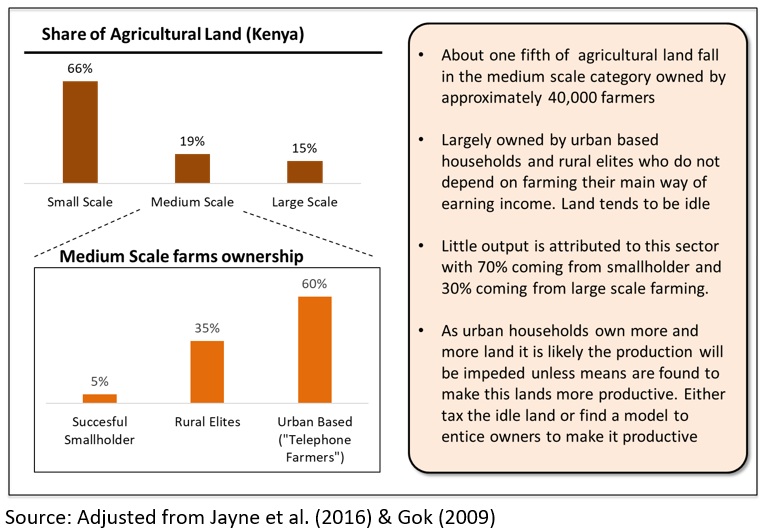Building the "Missing Middle" in Africa's Farming System
Smallholder farmers are the backbone of Agriculture in Africa, and prospects of African transformation are tied to their performance. For this reason, agriculture policy and donor support have been smallholder-centric, neglecting medium and large-scale agricultural enterprises. This blog discusses new trends and insights that call for rethinking this approach.
Revist Smallholder Farmer Centric Focus
Smallholder farmers are the backbone of Agriculture in Africa, and prospects of African transformation are tied to their performance. For this reason, agriculture policy and donor support have been smallholder-centric, neglecting medium and large-scale agricultural enterprises. New trends and insights call for a rethinking of this approach.
The smallholder farming model is becoming unsustainable as parcels become smaller and are farmed more intensively (Jayne et al., 2016; Heady & Jayne, 2014). In tandem with the rising population, food markets are changing. Rising incomes and urbanization are driving diet shifts[1] resulting in an increasing demand for food that is easy to prepare, e.g. rocessed foods[2] and new retailing formats, e.g. supermarkets[3]. Demand for processed food requires a strong agro-processing sector, which calls for a farm system that guarantees consistent supply, consistent quality, and low prices, which many smallholders find hard to fulfil. Participating in supermarket value chains is also a challenge for many smallholder farmers. Supermarket orders are huge (as they want to reduce transaction costs), and quality specifications (both health and visual) are also very high. Many smallholders are challenged to meet these requirements (Reardon & Berdegue, 2002; Rao et al., 2012).
Collier & Dercon (2014) make a case for large-scale farming on the argument that: i) they are essential in feeding the growing urban population as they produce surplus (many farmers in rural areas do not produce a net surplus, making them net buyers of food), (ii) commercial farming can create rural employment for many smallholder farmers in rural areas, especially the net food buyers; (iii) they can adopt and adapt new technologies to local conditions and thus boost yields. However, attempts to achieve this by attracting foreign direct investment in agriculture met with resistance, as it was seen as a new battle for Africa and was soon labelled “land grabbing” (Denniger et al 2011)[4].
The Emergent Farmer – Urban Based Middle Class (The Telephone Farmer)
A more interesting trend in Africa calls for sharper attention to the medium-scale farm sector. Around Africa, the middle class has been buying agricultural land as an investment. To date, around 20 to 30 per cent of agricultural land is owned by these urban-based land owners. Much of the land falls in the medium-scale category (5 to 100 ha) (Jayne et al., 2016).

These urban-based farmers manage their farms off-site through telephone communication usually asking neighbours and relatives to perform certain tasks, hence introducing the term “telephone farmer” (Leenstra, 2014). However, they lack an effective model to farm, and telephone farming has proved unprofitable (van Dijk et al., 2022). A study in Kenya (Leenstra, 2014) found that:
- They lack requisite skills for farming and are largely absentee farmers, so it is hard for them to supervise farming effectively
- To overcome lack of skills, they hire farm operators or farm managers. However, relationships tend to be characterized by friction, mistrust and poor communications
- They also encounter difficulties in identifying and recruiting the right skills needed to run a farm effectively.
Many have given up farming, leaving the land idle. The Kenyan Ministry of Agriculture pointed out that 70 per cent of output can be attributed to smallholder farmers and 30 per cent to large farms (GoK, 2009). The Kenyan government has mused with the idea of taxing idle land to make to force owners to bring it into production (Omondi and Samuel, 2018).

Medium Scale Farm Sector is The Glue Towards a Symbiotic Farm Ecosystem
It is essential to bring this idle land into production to activate the medium-scale farmer. Beyond contributing to food security, developing the medium-scale sector can stimulate agricultural productivity, value chain upgrading and overall transformation of the sector and the economy. Indeed the absence of a significant medium-scale sector in Africa has been termed the missing middle in the African farm system (ACET 2017).
A symbiotic collaboration between the small, medium, and large-scale agricultural sectors can promote specialization, the key to transformation. A good example is the Kenyan dairy sector. It demonstrates the power of solid ecosystems to drive specialization. In this sector, smallholder farmers focused on milk production, whereas medium-scale farmers focused on producing quality cows (for distribution to smallholders), and large-scale farmers focused on importing breeds and adapting them to Kenyan conditions (ACET, 2015). The presence of medium-scale farmers avail machinery that can be available to smallholder farmers Chapoto et al., 2014). For example, in Ghana, medium-scale farmers use less than 10 per cent of the capacity of their tractors and rent out the rest of the capacity to nearby smallholders.[1]
Medium-scale farmers are also a catalyst to value chain upgrading by attracting investments to upgrade the value chain. In Kenya, for example, the rise of medium-scale farmers has also attracted Large Scale Traders (LST) who have invested in logistics, improved coordination in the value chain, and saw higher prices offered to smallholder farmers. In addition, LST have also offered extension advice, price information and credit to smallholder farmers (Sitko et al., 2018). The supermarket revolution in Kenya has also been associated with the presence of medium-scale farmers who have the scale and capacity to meet supermarkets’ high standards. These farmers also tend to subcontract smallholder farmers to fulfil their orders, thus creating markets and upgrading the smallholder farmers (Evers et al., 2014, Rao et al., 2012). The medium-scale sector can thus play a crucial rural in transforming agriculture.
Towards a Business Model for the Urban Based Telephone Farmer
Building the missing middle will require developing a model that addresses the challenges faced by the urban-based medium-scale farmers, i.e. “telephone farmers”. One proposed model has been building a franchise farm services ecosystem that utilizes an internet platform to allow urban-based farmers to order services. Young entrepreneurs are trained and incubated to provide services (with backstopping by technical services providers) and are subcontracted to a service provider through a franchise. The franchise model ensures quality. The internet platform provides visibility to all farmers and thus can be leveraged to attract buyers and banks to provide credit (Van Dijk et al., 2022).
Agricultural-driven transformation prospects of Africa lie in building the missing middle of medium-scale farmers and a symbiotic farm ecosystem where all the farm segments work together. There is a need to shift from smallholder centric focus to a focus on building a symbiotic farm ecosystem with small, medium, and large-scale farmers working in concert. In this way, a farm services industry can emerge that can provide jobs for young people. In addition to a vibrant logistics and agro-processing sector that can help create rural non-farm jobs.
[1] Bennett’s Law predicts diet transformation that involves a relative move away from cereals and tuber staples towards meat, fish, eggs, dairy, fruits and vegetables, and fats as incomes rise (Haggblade et. al. 2016).
[2] Examining the emerging diet transition in East and Southern Africa, Tschirley et al. (2015) found that processed food now holds a 39% share of all food expenditure
[3] A study in China found that 1% rise in urbanization leads to a 5% rise in supermarket sales while $1 increased in disposable income raises supermarket sales by $0.27. (Hu et al 2004 cited in Trall 2006). South Africa with 65% of the food distributed through supermarkets may be an anomaly in Africa, but also more likely a pointer to the future of the food distribution landscape.
[4] The secrecy of the many land deals between governments and foreign investors has given credence to this though many have pointed out that the ‘land grab’ has been highly exaggerated (Denniger et al 2011).
[5] In Ghana medium scale farmers are selling excess capacity of their machinery to smallholder farmers thus increasing access to machinery. Houssou et. al. (2013) finds that on average, the owner of the tractor ploughed 20 hectares of farmland while ploughing about 163 hectares for other farmers as a paid service .
Bibliography
ACET. (2014). 2014 African Transformation Report. Growth with Depth. African Center for Economic Transformation (ACET). Retrieved from https://acetforafrica.org/?download=4946
ACET. (2015). Promoting Sustainable Rural Development and Transformation in Africa - Kenya Country Report. Accra: African Center for Economic Transformation (ACET). Retrieved from https://acetforafrica.org/?download=8620
Chapoto, A., N. Houssou, A. Mabiso, and F. Cossar. (2014). Medium and Large-Scale Farmers and Agricultural Mechanization in Ghana: Survey Results. Washington, DC International Food Policy Research Institute (IFPRI).
Collier, P. and Dercon, S., (2014). African Agriculture in 50 Years: Smallholders in a Rapidly Changing World? World Development Vol. 63, pp. 92–101, 2014. https://doi.org/10.1016/j.worlddev.2013.10.001
Deininger, K., Byerlee, D., Lindsay, J., Norton, A., Selod, H., Stickler, M., 2011. Rising Global Interest in Farmland: Can It Yield Sustainable and Equitable Benefits? World Bank Publications, Washington, DC. https://openknowledge.worldbank.org/handle/10986/2263
Evers, B., Opondo, M., Barrientos, S.W., Krishnan, A., Amoding, F., & Ndlovu, L.B. (2014). Global and Regional Supermarkets: Implications for Producers and Workers in Kenyan and Ugandan Horticulture. Working Paper No. 39, Capturing the Gains. Downloaded from https://www.research.manchester.ac.uk/portal/files/85193716/ctg_wp_2014_39.pdf
Heady, D., Jayne, T.S. ( 2014). Adaptation to Land Constraints – Is Africa Different? Food Policy, 48, 18–33. https://doi.org/10.1016/j.foodpol.2014.05.005
Jayne, T. S., Chamberlin, J., Traub, L., Sitko, N., Muyanga, M., Yeboah, F. K., Anseeuw, W., Chapoto, A., Wineman, A., Nkonde C., & Kachule, R. (2016). Africa’s changing farm size distribution patterns: the rise of medium‐scale farms. Agricultural Economics, 47(S1), 197-214. https://doi.org/10.1111/agec.12308
Leenstra, M., (2014). From suitcase farmers to telephone farmers. Agriculture and diversified livelihoods among urban professionals. In Digging deeper: Inside Africa’s Agricultural, Food, And Nutrition Dynamics. (pp. 217-231). Brill. Downloaded from https://scholarlypublications.universiteitleiden.nl/access/item%3A2871247/view#page=245
GoK (2009). Strategic Plan 2008-2012: Ministry of Agriculture, Livestock, Fisheries, and Co-operatives. Government of Kenya (GoK)
Houssou, N., Diao, X., Cossar, F., Kolavalli, S., Jimah, K., Aboagye, P.O. (2013). Agricultural mechanization in Ghana: is specialized agricultural mechanization service provision a viable business model? American Journal of Agricultural Economics 95 (5), 1237–1244. https://doi.org/10.1093/ajae/aat026.
Omondi, G. & Samuel, K (2018). Tax on idle land to be introduced. Business Daily, FRIDAY APRIL 13 2018. Retrieved from https://www.businessdailyafrica.com/bd/economy/tax-on-idle-land-to-be-introduced-2197930
Reardon T., and J.A. Berdegué (2002). “The Rapid Rise of Supermarkets in Latin America: Challenges and Opportunities for Development”. Development Policy Review, Vol. 20, Number 4, pp. 371-388. Downloaded from https://www.iese.ac.mz/lib/saber/eaf_014.pdf
Rao, E.J.O., B. Brümmer, M. Qaim. (2012). Farmer Participation in Supermarket Channels, Production Technology, and Efficiency: The Case of Vegetables in Kenya. American Journal of Agricultural Economics 94: 891–912. https://doi.org/10.1093/ajae/aas024
Sitko, N., J,. W. J. Burke & T.S. Jayne (2018). The Quiet Rise of Large-Scale Trading Firms in East and Southern Africa. The Journal of Development Studies. Volume 54, 2018 https://doi.org/10.1080/00220388.2018.1430773
Van Dijk, M. P., Limpens, G., Kariuki, J. G., & De Boer, D. (2022). Telephone farmers and an emerging ecosystem are unlocking the hidden middle of agricultural value chains in Kenya through innovation. Journal of Agribusiness in Developing and Emerging Economies 11(5), 1-16. https://doi.org/10.1108/JADEE-03-2021-0059
Also read
-
Aurélie Carlier receives Athena Award
Aurélie Carlier receives the Athena Award. This award is for exceptional female researchers who serve as role models through their successful scientific careers.
-
Despite a less tight labour market no end to shortages in healthcare, education, and tech
Interesting new findings in the report 'The Labour Market by Education and Occupation until 2030' from the Research Centre for Education and the Labour Market (ROA) at Maastricht University.
-
Protecting children’s rights in non-existent states
What happens to the universal rights of a child when their home is a “de-facto” state—a political entity that has all the hallmarks of nationhood, yet is not officially recognised? And who bears legal and moral responsibility for these children when war breaks out? These issues lie at the heart of the...